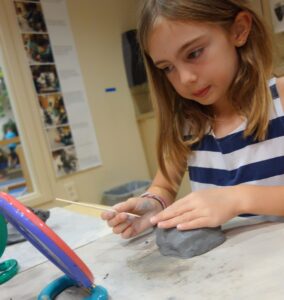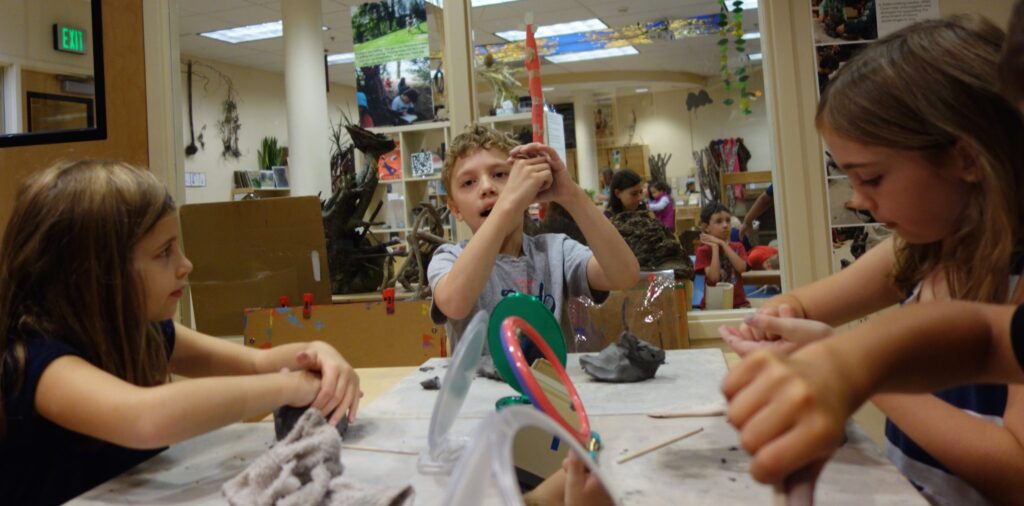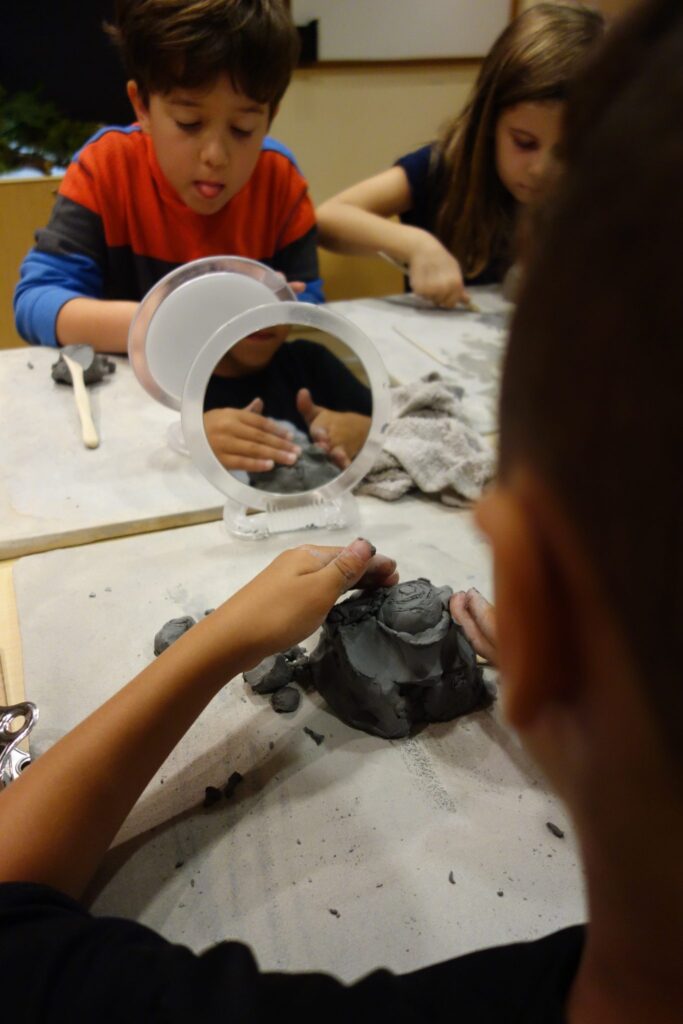Seeing Ourselves in Clay

As you know from our recent blog post that included our letter of intention to families, the Primary Community is focusing on research into the “self” this year. As an artist and educator who works with materials, I know that thinking about oneself involves paying attention to ourselves, asking questions, and even deconstructing ourselves in as many ways as we can conceive. One way we might expose assumptions of our selves is through paying attention to the visual, physical aspects. Self-portraiture has often been a component of this type of research. So far, for me that has involved using some variation of using the materials of black line pen or loose parts for portraiture.
So… I’ve done that and the children in our first and second grades have done that. I have learned a lot from using those materials with children of a variety of ages, and I recognize that it is certainly worth me exploring more in the future. But this year, in the initial moments that I began to consider how first and second graders might begin their inquiry into the physical self, I was feeling saturated with those familiar material provocations. I had a strong feeling that I wasn’t going to be able to stay in inquiry with the children about the material, nor in the way the children might approach the capturing of what they noticed.
Black line felt too “black and white,” “right and wrong,” or too certain and fixed. And while loose parts felt flexible, it didn’t offer the breadth of affordance to show the small details that I knew 6-8 year-old children would be noticing as they looked into their mirrors at their faces
It didn’t seem like, at this juncture, that it was going to be exciting to me, or for the children, from a research stance. I was itching for a material for the children that was both familiar yet fresh, but also very resilient and sympathetic to their touch and their inevitable re-adjustments. Something that the children recognized, but that might feel like they still have more to explore. So, I decided I would offer them clay.

When I went back to finish this blog post, I had just listened again to Obama’s speech given Saturday at the opening of the National Museum of African American History. As I was reflecting on his spoken words, I took note of his mention of Walt Whitman’s epic poem “Song of Myself.” Obama paraphrased Whitman, “We are large. Containing multitudes,” then added, “That’s what makes us gold. That’s what makes us extraordinary.” It seemed to me that he was saying that we are never just one thing, that we are much larger than that, that we are, with all our complexities and gifts and oopsies, very much alike one another. Not despite, but in fact because of each of our own unique blends of race, culture and gender. When I searched and began to read the actual lengthy, poetic work of Whitman, many of his words kept sticking with me as having such rich connections to the Primary Community’s journey this year. I’m sure I will further unpack the profound words of both Whitman and Obama as the year progresses, but for now I’m simply reveling in the big idea brought to the surface for me, that…
There is celebration to be had in the poetic musing, wondering,
and conversation about what is uniquely each of us and
what is universally all of us.
As a primary community, we are very early on in our exploration into self and all the relationships attached to that, but with this recent big idea as my lens, my observations of the children are feeling more and more important to document and support as we move forward.
I want to share with you some of what I’ve observed so far…
Teacher: How will you use the mirror and touching your face to help you sculpt your first drafts of a part of you?
Zion: [Looking in his mirror at his eye] How can I make a circle?
Kaleo: I think it’s more like an oval with bent edges.
Zion: Oh, yea… It is oval. There’s so many parts! There’s all these little lines and colors in the circle part.
Parker: There’s so… many parts! …I feel a ditch.
Emmanuel: The ditch technically holds your eye. The eye, I think, is being held in place.
Zion: If that ditch wasn’t there your eye would probably fall out.

Alison: There’s so many parts. We are so complicated. ….Let me see your eye, Parker.
Emmanuel: [Feeling his socket.] Your eye is pretty big under your eyebrow. You can feel almost all the way around it, like a ball. Your eye fits perfectly into all of the ditch.
Zion: …Ya, the world never ends!
Parker: If it never ends, then how will we make all those parts?
Teacher: Does anyone have a strategy to help Parker consider how to begin?

Alison: Parker, I started with the ditch and made the eyeball fit in. Then I squished it into shape. The eyelashes are going to be really hard to make. ….I wonder how many eyelashes I have? How many do you think you have, Zion?
Zion: I have 4,585 eyelashes [His mouth smiling wide].
Kaleo: If I look really closely, I can really see hundreds of hairs! ….This is going to take a long time.
 During our 45 minutes together in clay, the children in this small group found themselves slowing down to look closely and marvel. I heard them trying to piece together the architecture of their anatomy and share strategies for attempting to re-creating it. The earth, as Zion offered, made a metaphor for the whole group to consider the complex and beautiful details of each of us and the interconnected-ness of us all. Clay, I feel, was the right choice this time.
During our 45 minutes together in clay, the children in this small group found themselves slowing down to look closely and marvel. I heard them trying to piece together the architecture of their anatomy and share strategies for attempting to re-creating it. The earth, as Zion offered, made a metaphor for the whole group to consider the complex and beautiful details of each of us and the interconnected-ness of us all. Clay, I feel, was the right choice this time.
In going back to Zion’s offering that day, he brings me back to Whitman’s poem, that starts with a similar metaphor:
I celebrate myself, and sing myself,
And what I assume you shall assume,
For every atom belonging to me as good belongs to you.
I’m left with so many big questions, but will only leave you with a few…
How will fostering the curiosity of wanting to know more about ourselves increase our awareness of others and the belief in belonging to one another?
How will exploring our anatomy and physiognomy nurture our self-awareness? How will our self-awareness support us to have agency for our actions and intentions?
What is the role of asking questions and staying in a place of inquiry in this work?
What is the role of materials in supporting us to slow down and pay attention to the unique details of self? …to the unique details in others …and to the consequential details we share?
I’m curious:
What are you celebrating about your journey and your community as the year begins to unfold amongst this political discourse?
What role do you think poetry and metaphor have in building understanding?

One of the many things I love about this post is the emphasis on children’s incredible capacity for complex and profound thought. You highlight this with Obama’s paraphrasing: “We are large. Containing multitudes,” then added, “That’s what makes us gold. That’s what makes us extraordinary.” Too often, children and the activities they do in elementary school are seen as simple and yet so much can live within each of these experiences.
Your work also reminds me of Maya Angelou’s words, “In all my work what I try to say is that as human beings we are more alike than we are unalike.
Thank you for this post!